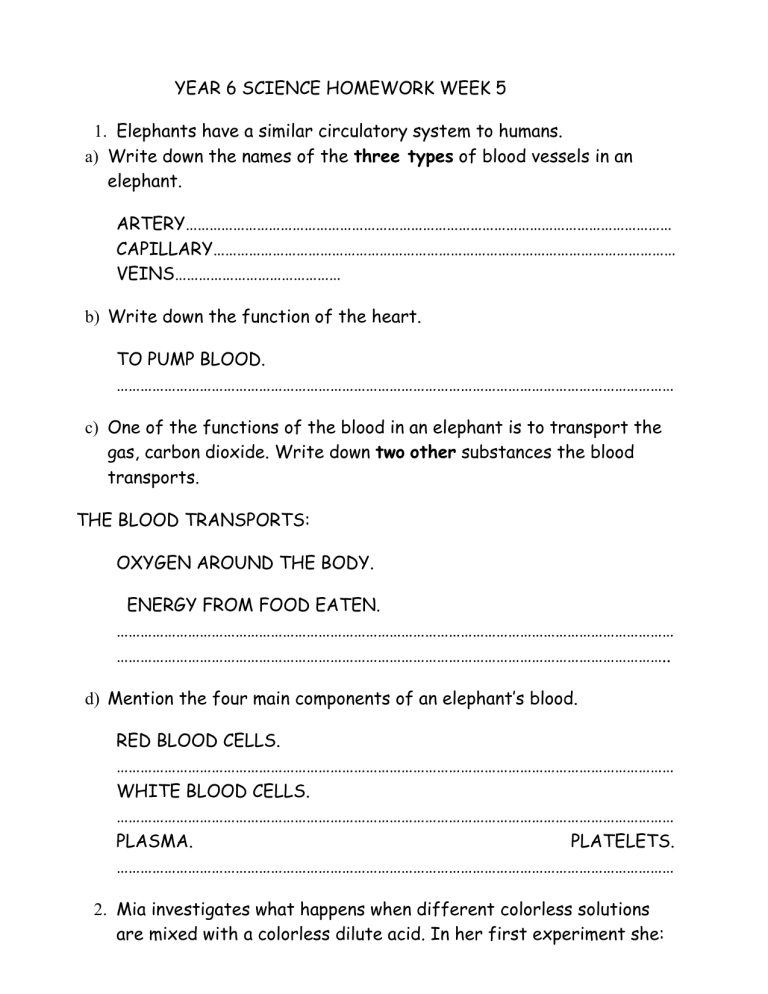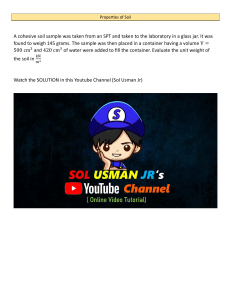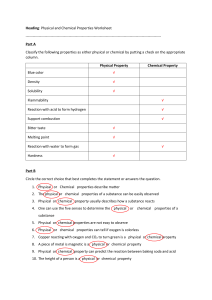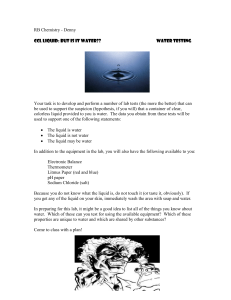
YEAR 6 SCIENCE HOMEWORK WEEK 5 1. Elephants have a similar circulatory system to humans. a) Write down the names of the three types of blood vessels in an elephant. ARTERY…………………………………………………………………………………………………………… CAPILLARY……………………………………………………………………………………………………… VEINS…………………………………… b) Write down the function of the heart. TO PUMP BLOOD. …………………………………………………………………………………………………………………………… c) One of the functions of the blood in an elephant is to transport the gas, carbon dioxide. Write down two other substances the blood transports. THE BLOOD TRANSPORTS: OXYGEN AROUND THE BODY. ENERGY FROM FOOD EATEN. …………………………………………………………………………………………………………………………… ………………………………………………………………………………………………………………………….. d) Mention the four main components of an elephant’s blood. RED BLOOD CELLS. …………………………………………………………………………………………………………………………… WHITE BLOOD CELLS. …………………………………………………………………………………………………………………………… PLASMA. PLATELETS. …………………………………………………………………………………………………………………………… 2. Mia investigates what happens when different colorless solutions are mixed with a colorless dilute acid. In her first experiment she: • measures the temperature of the acid in a glass beaker • adds a small volume of a colorless solution • measures the temperature of the mixture in the glass beaker • records any other observations. Mia repeats the experiment five more times with different colorless solutions. Look at the results of her investigation. temperature temperature solution of acid at start in °C after mixing in °C A 20 20 bubbles in a colorless solution B 20 32 bubbles in a colorless solution C 20 14 colorless solution D 20 20 white solid E 20 20 colorless solution F 20 28 green solution colorless observations a. Which colorless solution gives the greatest temperature change? B…………………………………………………………………………………………………………………….… ….. b. Which colorless solution does not react with the acid? C………………………………………………………………………………………………………………………... c. Give two reasons for your answer. IT HAS THE LOWEST REACTION. ………………………………………………………………………………………………………………… …… ii) ………………………………………………………………………………………………………………… …… 3. Soils are a mixture of clay, sand and an organic content called humus. Chen investigates the drainage of some dry soils. Chen: i) • places 20 g of dry soil W into the equipment shown • pours 50 cm3 of water onto the dry soil • measures the volume of water that drains into the measuring cylinder in one minute. • repeat the experiment for each of the dry soils, X, Y and Z. Chen’s results are shown in this table. soil percentage of clay sand humus volume of water collected after one minute in cm3 W 20 70 10 30 X 15 75 10 36 Y 70 20 10 10 Z 50 40 10 20 a. Look at the diagram. It shows the measuring cylinder of water collected for soil Z. 25 20 15 10 Write down, in Chen’s results table, the volume of water collected for soil Z. b. Explain why the volume of water added to the dry soil is always 50 cm3. …………………………………………………………………………………………………………………………… …………………………………………………………………………………………………………………………… c. Write down the dependent and the independent variable in this investigation. Dependent ……………………………………………………………………………………………………… Independent…………………………………………………………………………………………………… d. Which soil has the best drainage? Circle the correct answer. [1] W X Y Z ANSWER:X (e) Chen repeats the investigation with a dry soil containing 90% sand and 10% humus. Predict the volume of water collected. 36 cm3 4. Carlos investigates the time it takes salt to dissolve in water. In his first experiment Carlos: • pours 100 cm3 of water into a glass beaker • measures the temperature of the water • adds 5 g of salt to the water • stirs the mixture • records the time taken for the salt to dissolve. Carlos repeats the experiment using different temperatures of water. Look at the results of his investigation. temperature of water in °C time taken for salt to dissolve in seconds 20 120 30 60 40 31 50 14 60 7 a) Describe the pattern in these results. NUMBERS ARE GOING HIGH TO LOW. …………………………………………………………………………………………………………………………… …………………………………………………………………………………………………………………… b) Plot a bar graph temperature of water against time taken for the salt to dissolve to show the results above. c) Use the particle model to explain this pattern. …………………………………………………………………………………………………………………………… ………………………………………………………………………………………………………………………… 5. Complete the sentences. Choose from the words below. Break Soil Rock The earth crust consists of ROCK. Rain and ice BREAK up the rocks. The small rock particles become SOIL. This question is about objects in the Solar System. (a) Complete the table by adding the correct name of each planet. planet distance from the Sun in millions of km MERCURY 58 VENUS 228 EARTH 108 MARS 150 JUPITER 4495 SATURN 2871 URANUS 1434 NEPTUNE 779 (b) A planet moves in a path around the Sun. Write down the name of this path. ORBIT………………………………………………………………………………………………… ………… (c) The Moon moves around the Earth. Circle the time it takes the Moon to complete one cycle around the Earth. 24 hours 28 days 1 week 365 days 28 DAYS





